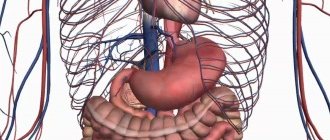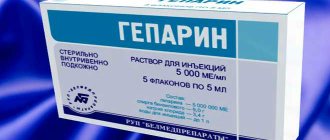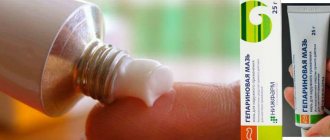Instructions for use
Hepatrin belongs to the category of hepatoprotective drugs, but it is not considered a drug. The supplement is always accompanied by instructions with explanations from the manufacturer. The main points are duplicated on additional packaging. The instructions describe the composition of the drug, the principle of its action on the body and liver, and explain the scheme of use. When using Hepatrin in complex treatment, the principle of taking the supplement, dosage and course duration can be changed by the attending physician.
pharmachologic effect
The substances that make up Hepatrin mainly affect the liver. The drug restores some organ functions, improves its performance, and normalizes cell regeneration processes. The maximum therapeutic effect is achieved with a course of taking the supplement. Hepatrin not only improves the functioning of the liver, but also increases its protective functions.
Taking the supplement is especially recommended if there is a serious impact of negative factors on the organ.
Pharmacological properties:
- hepatoprotective properties;
- providing the liver with essential phospholipids;
- improving the process of bile production;
- accelerating the process of removing toxins from the body;
- increased platelet and erythrocyte aggregation;
- normalization of hemoglobin synthesis;
- restoration of damaged liver cells;
- increasing local immunity;
- accelerating the healing process in the presence of pathologies.
At first, alcohol intoxication is still reversible, and when the abuse stops, liver function will gradually recover almost completely. But if people continue to abuse alcohol, then irreversible changes occur in the organ.
Indications for use
Hepatrin is most effective when used as a prophylactic agent. The supplement can prevent the development of pathological processes in the liver due to abuse of bad habits, exposure to negative external factors, or the progression of diseases that can provoke abnormalities in the functioning of the organ.
The drug combines well with other medications. This nuance allows it to be used during complex therapy.
The drug is prescribed in the presence of the following conditions:
- alcohol intoxication;
- parasitic liver damage;
- consequences of the negative impact of external factors;
- drug intoxication;
- consequences of long-term abuse of bad habits (smoking, alcohol, etc.);
- liver cirrhosis, hepatitis and other acute and chronic diseases;
- improper diet (fatty, fried, smoked foods);
- negative consequences of infectious and viral diseases;
- exposure to unfavorable surrounding atmosphere.
Mode of application
The recommended dosage of the drug is two capsules per day (in two divided doses). The duration of one course of use should not exceed one month. During this period of time, the maximum therapeutic effect is achieved.
A repeated course is allowed no earlier than two months later. If there are special indications, the duration of taking Hepatrin can be increased to three months. To prescribe such a course, it is necessary to identify chronic liver diseases in the patient.
The drug cleanses and reduces liver intoxication, protects and restores liver cells and all functions of the organ as a whole.
Method of use of different forms of the drug:
- capsules should be taken after meals (with a small amount of liquid);
- Before use, the powder is dissolved in one third of a glass of water (room temperature);
- The duration of taking the drink is limited to ten days.
Release form and composition
Hepatrin is available in the form of capsules (30 or 60 pieces in one package) or powder for preparing a drink. The composition of the drug in different release forms differs. The powder contains taurine, B vitamins, diaminovaleric acid and auxiliary components in the form of fructose, succinic acid, acacia gum, colloidal silicon dioxide and xanthan gum. The capsules do not contain any additional substances. Their composition is represented by several types of active components.
Composition of capsules:
- B vitamins (B1, B6, B2);
- vitamin E;
- essential phospholipids;
- silymarin (milk thistle extract);
- artichoke extract.
Interaction with other drugs
The manufacturer does not note the nuances of the interaction of Hepatrin with medications of other categories. The composition of the drug includes herbal components and vitamins. These substances are not capable of interfering with the action of other medications, but the supplement has a choleretic and hepatoprotective effect.
If there is a need to take medications with such actions, then a doctor should be involved in drawing up a course of therapy.
Dietary supplement that contains milk thistle extract, Artichoke, Lecithin and B vitamins.
Description of the drug HEPARIN
Direct anticoagulant, belongs to the group of medium molecular heparins. In blood plasma, it activates antithrombin III, accelerating its anticoagulant effect. It disrupts the transition of prothrombin to thrombin, inhibits the activity of thrombin and activated factor X, and to some extent reduces platelet aggregation.
For unfractionated standard heparin, the ratio of antiplatelet activity (antifactor Xa) and anticoagulant activity (APTT) is 1:
- 1.
Increases renal blood flow; increases cerebral vascular resistance, reduces the activity of cerebral hyaluronidase, activates lipoprotein lipase and has a hypolipidemic effect. Reduces the activity of surfactant in the lungs, suppresses excessive synthesis of aldosterone in the adrenal cortex, binds adrenaline, modulates the ovarian response to hormonal stimuli, and increases the activity of parathyroid hormone. As a result of interaction with enzymes, it can increase the activity of brain tyrosine hydroxylase, pepsinogen, DNA polymerase and reduce the activity of myosin ATPase, pyruvate kinase, RNA polymerase, pepsin.
There is evidence that heparin has immunosuppressive activity.
In patients with coronary artery disease (in combination with ASA), it reduces the risk of acute coronary artery thrombosis, myocardial infarction and sudden death. Reduces the frequency of recurrent infarctions and mortality in patients who have had myocardial infarction. In high doses it is effective for pulmonary embolism and venous thrombosis, in small doses it is effective for the prevention of venous thromboembolism, incl. after surgical operations.
With intravenous administration, blood coagulation slows down almost immediately, with intramuscular injection - after 15-30 minutes, with subcutaneous administration - after 20-60 minutes, after inhalation the maximum effect is within 24 hours; the duration of the anticoagulant effect is respectively 4-5, 6, 8 hours and 1-2 weeks, the therapeutic effect - prevention of thrombus formation - lasts much longer. Deficiency of antithrombin III in plasma or at the site of thrombosis may reduce the antithrombotic effect of heparin.
When applied externally, it has a local antithrombotic, antiexudative, and moderate anti-inflammatory effect. Blocks the formation of thrombin, inhibits the activity of hyaluronidase, and activates the fibrinolytic properties of the blood. Heparin penetrating through the skin reduces the inflammatory process and has an antithrombotic effect, improves microcirculation and activates tissue metabolism, thereby accelerating the processes of resorption of hematomas and blood clots and reducing tissue swelling.
Side effects
Hepatrin contains herbal components, which, if individually intolerant, can provoke a number of negative symptoms. The risk of side effects increases with uncontrolled use of the drug. Disturbances can occur from the digestive system, blood pressure and in the form of a deterioration in the general condition of the body. If side symptoms occur, you must stop using the supplement and consult a doctor.
Side effects:
- allergic rashes on the skin;
- deterioration of the general condition of the body and headaches;
- decreased blood pressure;
- attacks of nausea or vomiting;
- pain in the epigastrium;
- convulsive conditions;
- lethargy and drowsiness;
- increased symptoms of flatulence;
- intestinal disorders.
Overdose
If the product is used incorrectly, the instructions for use of Hepatrin warn about the possible occurrence of bleeding.
There have been no cases of Hepatrin overdose in medical practice. Regular overestimation of prescribed dosages can cause an excess of vitamin B in the body. This effect will not provoke serious consequences for the body, but the effectiveness of the therapy will be impaired.
Negative symptoms can manifest themselves at maximum intensity if there is an individual intolerance to the components of the supplement. Exceeding dosages is highly discouraged.
Contraindications
In medical practice, Hepatrin is allowed to be used for patients over twelve years of age. The drug is not prescribed for young children. An absolute contraindication for prescribing the supplement is hypersensitivity to the components of its composition. If you are prone to allergic reactions, you must first undergo an examination and consult with a specialist.
Hepatrin is not used during pregnancy and lactation. The manufacturer of the supplement does not note any other contraindications.
During pregnancy
Hepatrin is not prescribed during pregnancy and lactation. The manufacturer does not provide information about the studies, but the components of the supplement may adversely affect the body of the fetus or newborn child. Artichoke and milk thistle extracts can cause an allergic reaction. If there is a need for treatment or prevention of liver pathologies in pregnant women, special drugs are prescribed, developed specifically for this category of patients.
Heparin
Heparin sodium is administered intravenously (as a continuous infusion or repeated boluses) or subcutaneously. Heparin sodium should not be administered intramuscularly due to the risk of developing intramuscular hematomas.
Subcutaneous injections are preferably performed in the anterior abdominal wall. As an exception, other injection sites can be used (outer thigh, shoulder) if subcutaneous adipose tissue is sufficiently developed. It is not recommended to re-inject sodium heparin into previous injection sites.
Recommended therapeutic (full) doses of heparin sodium for adult
patients:
| Continuous intravenous infusion | Initial dose | 5000-10000 IU IV bolus |
| Continuous infusion | 20000-40000 IU/day (administration rate is about 1000 IU/hour) | |
| Bolus intravenous introduction | Initial dose: | 10000 ME |
| Maintenance doses | 5000-10000 IU every 4-6 hours | |
| Subcutaneous introduction | Initial dose: | 333 IU/kg (with a body weight of less than 75 kg - 20,000 IU, with a body weight of 75-90 kg - 25,000 IU, with a body weight of 90-105 kg - 30,000 IU, with a body weight of more than 105 kg - 35,000 IU) |
| Maintenance doses | 250 IU/kg (15,000-25,000 IU) every 12 hours. |
Laboratory monitoring of the effectiveness and safety of sodium heparin therapy
The dose of heparin sodium should be adjusted based on laboratory blood clotting parameters. When using heparin sodium, it is necessary to monitor the activated partial thromboplastin time (aPTT) or blood clotting time (BCT). The administered dose of heparin sodium is considered adequate if the aPTT is 1.5-2.0 times higher than normal values or if the patient's ICT is 2.5-3.0 times higher than control values.
With continuous intravenous infusion
sodium heparin, it is recommended to determine the initial aPTT, then determine the aPTT every 4 hours, followed by increasing or decreasing the rate of sodium heparin infusion until the target aPTT level is reached (1.5-2 times higher than normal), then determine the aPTT every 6 hours.
With bolus intravenous administration
heparin sodium, it is recommended to determine the initial aPTT, then determine the aPTT before each bolus injection, followed by an increase or decrease in the administered dose of heparin sodium.
When administered subcutaneously
sodium heparin, it is recommended to monitor the aPTT 4-6 hours after injection with a subsequent increase or decrease in the administered dose of sodium heparin.
When using sodium heparin in low doses to prevent thromboembolic complications, it is not necessary to monitor the aPTT.
Use of heparin sodium in special clinical situations
Primary percutaneous coronary angioplasty for acute non-ST segment elevation coronary syndrome and ST-segment elevation myocardial infarction
: Heparin sodium is administered intravenously as a bolus at a dose of 70-100 U/kg (if the use of glycoprotein IIb/IIIa receptor inhibitors is not planned) or at a dose of 50-60 U/kg (when used together with glycoprotein IIb/IIIa receptor inhibitors).
Thrombolytic therapy for ST-segment elevation myocardial infarction:
Heparin sodium is administered intravenously as a bolus at a dose of 60 U/kg (maximum dose 4000 U), followed by intravenous infusion at a dose of 12 U/kg (not more than 1000 U/hour) for 24-48 hours. The target APTT level is 50-70 sec or 1.5-2.0 times higher than normal; APTT monitoring 3.6, 12 and 24 hours after the start of therapy.
Prevention of thromboembolic complications after surgery using low doses of sodium heparin:
s/c, deep into the fold of the skin of the abdomen. The initial dose is 5000 IU 2 hours before surgery. In the postoperative period: 5000 IU every 8-12 hours for 7 days or until the patient’s mobility is completely restored (whichever comes first). When using sodium heparin in low doses to prevent thromboembolic complications, it is not necessary to monitor the aPTT.
Application in cardiovascular surgery during operations using extracorporeal circulation systems:
the initial dose of sodium heparin is not less than 150 IU/kg body weight. Next, sodium heparin is administered by continuous intravenous infusion at a rate of 15-25 drops/min, 30,000 IU per 1 liter of infusion solution. The total dose of heparin sodium is usually 300 IU/kg body weight (if the expected duration of the operation is less than 60 minutes) or 400 IU/kg body weight (if the expected duration of the operation is 60 minutes or more).
Use in hemodialysis:
Initial dose of heparin sodium: 25-30 IU/kg (or 10,000 IU) intravenous bolus, then continuous infusion of heparin sodium 20,000 IU/100 mg sodium chloride solution at a rate of 1500-2000 IU/hour (unless otherwise indicated in the instructions for use of the systems for hemodialysis).
Use of heparin sodium in pediatrics:
Adequate controlled studies of the use of heparin sodium in children have not been conducted. The recommendations presented are based on clinical experience.
Initial dose: 75-100 units/kg IV bolus over 10 minutes
Maintenance dose: children aged 1-3 months - 25-30 Units/kg/hour (800 Units/kg/day), children aged 4-12 months - 25-30 Units/kg/hour (700 Units/kg/day day), children over 1 year old - 18-20 units/kg/hour (500 units/kg/day) intravenously.
The dose of heparin sodium should be adjusted based on blood coagulation parameters (target aPTT 60-85 seconds).
Analogs
Structural analogues of Hepatrin include drugs containing identical plant extracts. This nuance must be taken into account when selecting substitutes. For example, if Hepatrin provoked an allergic reaction, then other drugs with a similar composition will have an identical effect. In this case, a mandatory consultation with a specialist is necessary.
Hepatrin can be replaced with agents with similar pharmacological properties, but with other substances in the composition.
| A drug | Description |
| Essentiale | a drug for the treatment of liver diseases, has an effect at the cellular level, belongs to the category of hepatoprotective agents, the approximate cost is 600 rubles. |
| Ovesol | the supplement has a choleretic, antispasmodic and hepatoprotective effect, is used in the treatment of acute and chronic liver diseases, well cleanses the body of harmful substances and toxins, the average price is 340 rubles. |
| Karsil | The drug contains milk thistle extract, the product restores the functioning of the liver and protects the organ from the effects of negative factors, the approximate cost is 340 rubles. |
| Ursolak | hepatoprotective agent, belongs to the category of synthetic drugs, used for the treatment of pathological processes in the liver, including alcohol and drug intoxication, the average cost is 500 rubles. |
| Ursohol | the drug is used in the treatment of pathologies associated with impaired functioning of the biliary tract and liver, belongs to the category of hepatoprotectors, the approximate cost is 250 rubles. |
Reviews
Hepatrin is widely used for liver treatment in alternative medicine. Doctors do not recommend using this drug as the main means of treating diseases, but confirm its effectiveness when it is necessary to prevent pathologies. The supplement contains plant substances that normalize the composition of bile and the process of its removal from the body, eliminate toxins, and also significantly improve the overall functioning of the liver.
If you have experience using Hepatrin, be sure to share it with other site visitors.



